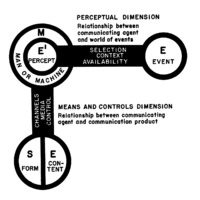-
Title
-
The Basic Generalized Graphic Model of Communication
-
Description
-
The basic generalized graphic model appears [in the Figure]. We match it against the verbal model to illustrate those aspects of communication that lend themselves to schematic representation, to point out those aspects that cannot be easily diagramed, and to demonstrate some unique features of the graphic model. "Someone …" appears on the generalized graphic model as a circle marked M for man or machine. M might be the destination of a message, or its originator, or both. M's relationship to the other elements in the diagram indicates its role. …The perceptual aspect of communication forms the link between events and their reflection, or sensory, creative, cognitive reconstruction in and by the communicating agent, M. The event perceived … is represented on the graphic model as an undivided circle marked E for event.Availability of the event (E) for perception by M is shown by a line leading horizontally from the E circle to the M circle. Its perception is indicated by leading this horizontal "selection-context-availability" line to a smaller circle inside M. This circle inside M is marked the same as the event plus a "prime" sign (') for "event as perceived." Thus [in the Figure,] event E is perceived by M as E'. …On our generalized graphic model means and controls appear as a vertical line relating M, the communicating agent, to SE, the communication product. Thus while the horizontal dimension indicates the perceptual process, the vertical axis denotes certain characteristics of the production and control aspect of communication: the means through which the communicating agent or agency creates, and distributes its communication products. …To carry a message, use of the means must be nonrandom. It must have some sequence, pattern, organization not found in single units or elements of its use; this is what we call its form. The formal characteristics of the communication product SE appear on the model as the half-circle S, for statement or signal, attached to the means axis and complemented by content E. … Thus signal or statement S never stands by itself. It is complemented by half circle E. The communication product SE has, therefore, signal, or formal, qualities (the S part), and content qualities (the E part) marking the fact that every signal or statement is about, or is occasioned by, some event.
-
Designer
-
Gerbner, George
-
Date
-
1956
-
Source
-
Toward a General Model of Communication
-
Bibliographic Citation
-
Gerbner, George. 1956. "Toward a General Model of Communication." Audio Visual Communication Review, Vol. 4, No. 3 (Summer, 1956). Figure 2. Pages 176-181.
-
depict things of type
-
English
Sequence or Process
-
is composed of
-
English
Circle
-
English
Square
-
Coverage
-
communication
-
diagram system
 Gerbner-Comm Model-8.png
Gerbner-Comm Model-8.png